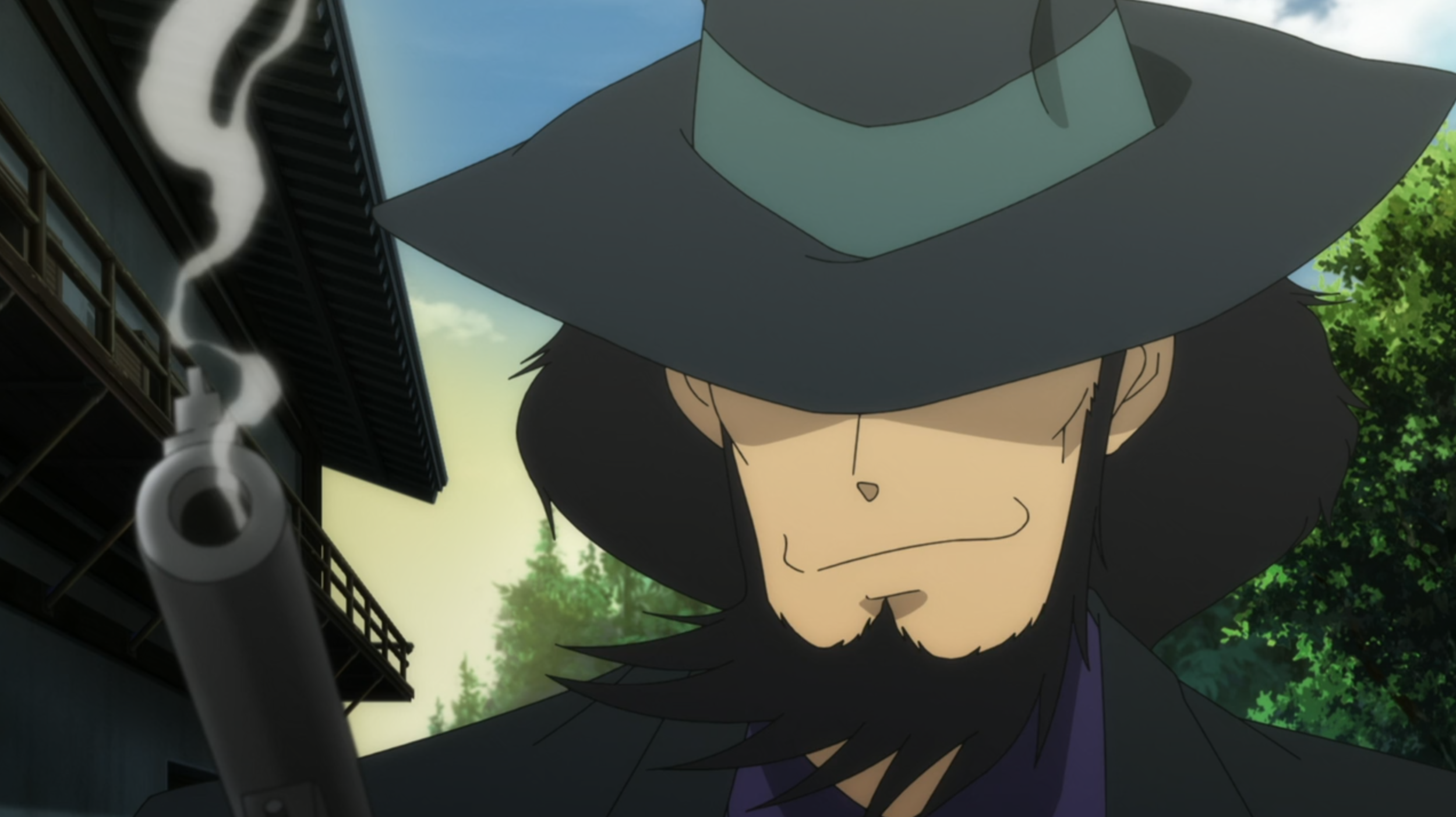Review: Part 6 “Episode 7 ~ An Untold Tale”
Welcome to our episode review of Lupin III: Part 6!
Our review is from the perspective of a “hardcore” Lupin III fan, who has seen every episode, film, and special the series has had to offer since its animated inception in 1969. The author's perspective on modern anime however, is lacking. When it comes to anime, we exclusively watch Lupin III, so cannot compare it to other shows on the market. Instead, we can only compare it with Lupin media of the past.
Be aware that there are SPOILERS ahead.
Please only read on if you either have seen the episode already, or do not mind learning about important character interactions and pivotal plot points in advance.
“Episode 7 ~ An Untold Tale” of Lupin III: Part 6 returns to present day London, as Lupin faces off with trained killer (and classic Sherlock Holmes character) Colonel Sebastian Moran.
Once again, the seventh episode has a heavy focus on set up and story exposition. Despite bringing viewers back to the present day, a large portion of screen-time is spent covering long detailed explanations of past events — in this case, the murder of Dr John. H Watson.
Colonel Sebastian Moran begins his time in the Lupin III franchise by scoping out Holmes and Lily. The former is now clean-shaven, and investigating a murder case involving a Mr. Warburton (yes, like the bread).
Having previously only investigated petty crimes to help gain a little extra cash to care for Lily, the detective now appears to be stepping up his game. Holmes swiftly solves the case, which resulted in a poisoning via famous Scottish soft drink IRN-BRU, and the police take things from there.
Lily is still suffering from extreme headaches (which is potentially PTSD), as a result of seeing Lupin after witnessing her fathers’ death, ten years ago. With Holmes busy on the beat, Lestrade picks up our once fiery heroine from school and escorts her home to a waiting Ms. Hudson.
The story quickly takes a turn, as Sebastian Moran’s sights switch to Lupin and Zenigata — both of which, seem happy to jump into the cross-hairs for Holmes’ sake. There’s an extremely brief chase sequence, before the pair become pinned down by our killer in a graveyard. The writers of the episode then see this as the perfect opportunity for story exposition, and as the pair cower behind two graves, Lupin details the events of ten years ago.
It is exactly as you may have suspected. Lupin showed up to the wrong place at the wrong time, stood by and watched Dr John H. Watson die at the hands of “the raven”, and then seemingly took the flak for it. Our hero didn’t intervene or take a shot, and then felt no need to explain himself when confronted by both Holmes and the victim’s four-year-old daughter, Lily. Despite letting Watson die, our hero does still step in to kill off the member of the raven after the fact. This implies Lupin couldn’t get a decent enough aim at his target beforehand. To me, this felt a little weak for a character that has often always gone the extra mile to defuse situations like this, and help others — but it still fits here. I suppose the location is a little misty, and visibility is low — although, that hasn’t stopped him before.
Lupin’s return to London was in an attempt to remind Lily of those events ten years ago, and help her work through her past traumas. Rather coldly, he explains to Zenigata that Lily should get over things, and try to remember the identity of the raven executioner, as it is likely she saw his or her face from the car. This attitude from Lupin is rather matter-of-fact, and while coming across as unsympathetic initially, I warmed up to this idea the more I thought about it. Lupin can be matter-of-fact — he gets a goal in sight, and will do what he needs to do to achieve it. I am not sure if this should involve pushing a fourteen-year-old girl through her past traumas and PTSD, manipulating others in the process, but I could certainly see a Lupin written in a darker tone doing this.
Back to the present day — Colonel Sebastian Moran still has both Lupin and Zenigata pinned down, but swiftly makes his exit after a strong advance from a cool and collected Inspector Zenigata. Once the pair have the upper hand, Moran explains that “the professor” is watching, likely a reference to his employer from the original source material, Professor Moriarty.
Moran skydives to safety, and we learn that Inspector Zenigata is, in fact, Sherlock Holmes in disguise.
I felt the idea behind Holmes donning a disguise to learn the truth about events ten years ago was clever and interesting. He played Lupin at his own game, was able to extract information from our thief, and chase off Moran in the process. Did Moran know that Holmes was in disguise as Zenigata? Is this why the aim of his pneumatic air gun shifted on to the pair? None of this is explained, however it is intriguing to think about.
Regardless of this, I do have one major problem with this idea, and it involves the involvement (or lack thereof) from Inspector Zenigata.
A rather fun scene earlier in the episode features Lestrade, Zenigata and “Yata” drinking together in a busy London pub. The trio discuss Holmes, and how people like him are helping render simple police inspectors like them irrelevant. Inspector Zenigata butts in, proclaiming only he can catch Lupin, and there’s no better person for the job. As the three continue to indulge in their pints, Zenigata mentions that he has a hunch something is about to go down tonight, and that Lupin is sure to show up.
As a fan of this show for over ten years now — I know Zenigata is always right. If he has a hunch Lupin will show, he will show, but yet — in this instance, Zenigata does not act. He continues to drink, passes out on the table, and this is where we find him come the episode’s end.
Lupin questions Holmes’ portrayal of Inspector Zenigata, explaining that “pops is never that much of a badass”. As his rival, this could just be a cheeky dig — but to me, it felt like the writers giving Zenigata’s character a disservice.
Zenigata is by far my favourite character from this franchise. The way he flip-flops between the coolest cop on the force and goofy failure is endlessly entertaining. He is, however, very rarely portrayed as a failure of his own accord. Lupin gets the better of him, but no-one else does. Sure, he’s tripped down some stairs exiting planes in Part 2, and accidentally arrested under-cover cops in Episode 0, but he’s not the sort to sleep on a job, especially one involving Lupin.
The way he was written out of this episode felt like a crime, and while he was passed out drunk in the pub, we missed out on some potentially fun Lupin and Zenigata character interactions. I can only hope he gets some better moments as this series progresses.
I was surprised to see the mystery surrounding Dr John. H Wilson’s killer wrap up so quickly, and was also disappointed with how this was told.
So far, Part 6 has felt like a series with a lot of set up and story exposition. Now, seven episodes in, I have an awkward feeling that the show is yet to even start. Most of the on-screen action we have seen is severely paired back from previous series, and the narrative twists feel weak in comparison.
Compare the sniper fight here with Moran, for example, with Part 5’s episode nineteen, “A 7.62mm Mirage”.
There’s some excellent tension, married with incredible action. Superb music from Yuji Ohno makes the climax to the fight fun, and it both looks and sounds a treat. The twist of who Jigen is firefighting with is interesting, and while introducing yet another one-shot female protagonist, of which there are plenty, it helps to enrich Jigen’s backstory.
Meanwhile, in Part 6, we never see a decent stand-off between Moran and any of the “hero” characters.
Instead, time in the heated moment is spent explaining story details, and the situation resolves itself in around two or three camera shots. This is disappointing to me — it feels very reserved, and as a result, it is part of the reason as to why I feel Part 6 is yet to truly begin.
Despite criticisms, “An Untold Tale” is a rather inoffensive, mediocre Lupin III episode.
There are a couple of interesting moments, wrapped up in rather dull storytelling. If you feel invested in the Lupin “versus” Sherlock Holmes stand-off, you may find something to like here. On the other hand, I use the term “stand-off” in the loosest way possible, as the feud between the two has become less of a battle and more of a conversation.
I am excited to uncover more about the mysterious “professor”, and potentially find out how Moriarty will be portrayed in the show. I must remind myself, however, not to expect much.
Part 6 seems sanitized, has become an exercise in tempering expectations, and thus far, feels about as least exciting as a Lupin series can get.








